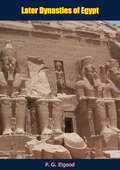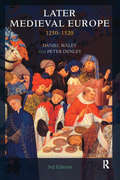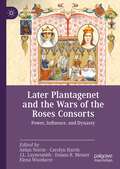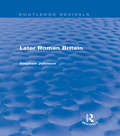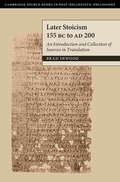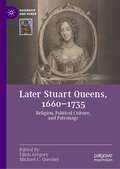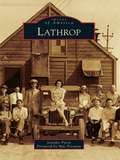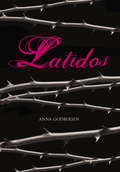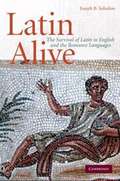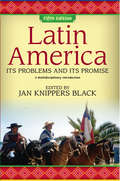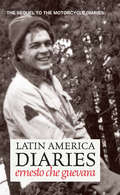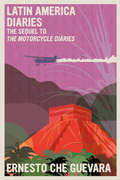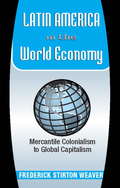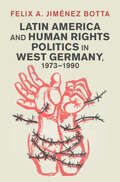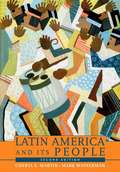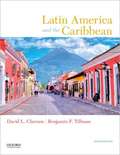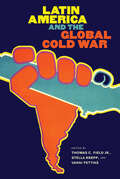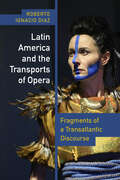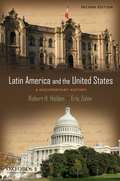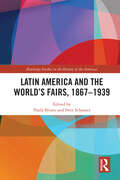- Table View
- List View
Later Dynasties of Egypt
by P. G. ElgoodFirst published in 1951, the present volume is a history of Egypt in its declining years. It details the Pharaonic struggle with the priesthoods over power, the intervention of the Ethiopians and the subsequent invasions by the Assyrians, Chaldeans and the Persians culminating in the arrival of Alexander the Great.“IN writing this book, the author desired, as in his previous work Ptolemies of Egypt, to interest the general reader in the ruling personalities in Egypt during a period when the fate of that country was as intertwined with that of its neighbour states as it is in modern days.”—P. G. Elgood
Later Medieval Europe: 1250-1520
by Daniel Waley Peter DenleyFrom the divine right of kings to the political philosophies of writers such as Machiavelli, the medieval city-states to the unification of Spain, Daniel Waley and Peter Denley focus on the growing power of the state to illuminate changing political ideas in Europe between the thirteenth and sixteenth centuries. Spanning the entire continent and beyond, and using contemporary voices wherever possible, the authors include substantial sections on economics, religion, and art, and how developments in these areas fed into and were influenced by the transformation of political thinking. The new edition takes the narrative beyond the confines of western Europe with chapters on East Central Europe and the teutonic knights, and the Portuguese expansion across the Atlantic. The third edition of this classic introduction to the period includes even greater use of contemporary voices, full reading lists, and new chapters on East Central Europe and Portuguese exploration. Suitable as an introductory text for undergraduate courses in Medieval Studies and Medieval European History.
Later Plantagenet and the Wars of the Roses Consorts: Power, Influence, and Dynasty (Queenship and Power)
by Elena Woodacre Carolyn Harris J. L. Laynesmith Aidan Norrie Danna R. MesserThis book examines the lives and tenures of the consorts of the Plantagenet dynasty during the later Middle Ages, encompassing two major conflicts—the Hundred Years’ War and the Wars of the Roses. The figures in this volume include well-known consorts such as the “She Wolves” Isabella of France and Margaret of Anjou, as well as queens who are often overlooked, such as Philippa of Hainault and Joan of Navarre. These innovative and authoritative biographies bring a fresh approach to the consorts of this period—challenging negative perceptions created by complex political circumstances and the narrow expectations of later writers, and demonstrating the breadth of possibilities in later medieval queenship. Their conclusions shed fresh light on both the politics of the day and the wider position of women in this age. This volume and its companions reveal the changing nature of English consortship from the Norman Conquest to today.
Later Roman Britain (Routledge Revivals)
by Stephen JohnsonLater Roman Britain, first published in 1980, charts the end of Roman rule in Britain and gives an overall impression of the beginning of the so-called ‘Dark Ages’ of British history, the transitional period which saw the breakdown of Roman administration and the beginnings of Saxon settlement. Stephen Johnson traces the flourishing of Romano-British society and the pressures upon it which produced its eventual fragmentation, examining the province’s barbarian neighbours and the way the defence was organised against the many threats to its security. The final chapters, using mainly the findings of recent archaeology, assess the initial arrival of the Saxon settlers, and indicate the continuity of life between late Roman and early Saxon England. Later Roman Britain gives a fascinating glimpse of a period scarce with historical sources, but during which changes fundamental to the formation of modern Britain began to take place.
Later Stoicism 155 BC to AD 200: An Introduction and Collection of Sources in Translation
by Brad InwoodMost modern readers of the Stoics think first of later authors such as Seneca, Epictetus and Marcus Aurelius. Existing works like Long and Sedley's The Hellenistic Philosophers concentrate on the Stoics of the early school. This book focusses on the more influential later school, including key figures like Panaetius and Posidonius, and provides well-chosen selections from the full range of Stoic thinkers. It emphasizes their important work in logic, physics and cosmology as well as in ethics. Fresh translations and incisive commentary present a picture of Stoic thought informed by up-to-date historical research and philosophical analysis. The book will be essential for scholars and students of ancient philosophy and of Hellenistic and Roman culture.
Later Stuart Queens, 1660–1735: Religion, Political Culture, and Patronage (Queenship and Power)
by Eilish Gregory Michael C. QuestierThis book gathers contributions on the later Stuart queens and queen consorts. It seeks to re-insert Henrietta Maria, Catherine of Braganza, Mary of Modena, Mary II, Anne, and Maria Clementina Sobieska into the mainstream of Stuart and early Georgian studies, concentrating on the later Stuart queens from the restoration of King Charles II (who married Catherine of Braganza in 1662) until the death of Maria Clementina Sobieska in 1735, who was married to James Francis Edward Stuart, the titular King James III, otherwise known as the Old Pretender. It showcases these women’s roles as queen consorts and as ruling queens in Britain and Europe, and reveals how their positions allowed them to act as power-brokers, diplomats, patrons, and religious trendsetters during their lifetimes. It also explores their impact in early modern Britain and Europe by assessing their influence in religion, political culture, and the promotion of patronage.
Lathrop
by Mac Freeman Jennifer PyronFirst home to Yokut Indians, then trappers, hunters, and fishermen, Lathrop was founded by Leland Stanford in 1869 as a railroad town and an answer to Stanford's frustration with his railroad attempts in Stockton. Lathrop's rich history includes the railroad, its Delta waterways, manufacturing and distributing industries, and the fascinating tale of California Supreme Court justice David S. Terry's murder (Terry had previously fought and won the last legal duel in California with U.S. senator David C. Broderick just outside of San Francisco). Reportedly named in honor of a relative of Leland Stanford Jr., today's Lathrop evolved from rugged railroad beginnings to a growing and vibrant community of close to 20,000 residents.
Latidos (Latidos #Volumen 1)
by Anna GodbersenUna historia de amor, rebeldía, glamour y misterio... Chicas deslumbrantes que celebran fiestas hasta el amanecer. Chicos irresistibles, con sonrisas hipnotizadoras y peligrosas. Mentiras, glamour, pasión y misterio. Bienvenidos a Manhattan, 1899. Los lectores dicen...«Una saga que me sació absolutamente en todo: primero porque tenía lo que yo buscaba, un ritmo que enganchara, que me hiciera querer seguir leyendo [#], segundo, una historia interesante, creo que la historia de Latidos es increíble, tercero personajes bien construidos, y cuarto algún trasfondo así, algo de lo que yo pudiera aprender al leer.»
Latin Alive: The Survival of Latin in English and the Romance Languages
by Joseph B. SolodowIn Latin Alive, Joseph Solodow tells the story of how Latin developed into modern French, Spanish, and Italian, and deeply affected English as well. Offering a gripping narrative of language change, Solodow charts Latin's course from classical times to the modern era, with focus on the first millennium of the Common Era. Though the Romance languages evolved directly from Latin, Solodow shows how every important feature of Latin's evolution is also reflected in English. His story includes scores of intriguing etymologies, along with many concrete examples of texts, studies, scholars, anecdotes, and historical events; observations on language; and more. Written with crystalline clarity, this is the first book to tell the story of the Romance languages for the general reader and to illustrate so amply Latin's many-sided survival in English as well.
Latin America
by Heidi Hayes Jacobs Michal L. Levasseur Brenda RandolphThe ancient peoples of Latin America built great civilizations from the riches of their land. Today, their descendants have mixed with newcomers from around the world to create a modern society with new traditions.
Latin America
by Jan Knippers BlackGives undergraduate students a broad understanding of the evolution of issues and theoretical frameworks in Latin American studies. Examines developments of the 1990s such as economic growth, privatization, and ecological awareness, and gives special attention to the expanding influence of Latin American intellectual, literary, and artistic contributions. Highlights of this third edition include discussions of the resolution of conflict in Central America, the trend toward redemocratization in South America, and the impact of drugs and debt throughout the region. Annotation c. by Book News, Inc. , Portland, Or.
Latin America
by Jan Knippers BlackNow in a fifth edition, Latin America has been updated to reflect the region's growing optimism as economies stabilize, trade diversifies, and political systems become more participatory. This multidisciplinary survey of Latin American history, politics, and society features invited contributions from authorities in a variety of fields. New sections address current events including deforestation in Costa Rica and Brazil, emerging social movements, Ecuador's new constitution, and Obama's stated objectives to repair U.S. relations with the region. In addition, key topics--such as women and Latin American politics, socialist governments and anti-American sentiment, Argentina's deteriorating economy, and Colombia's struggle with military and narcotics issues--receive expanded and revitalized treatment. Other updated material covers outcomes of recent elections in Bolivia, Brazil, and Nicaragua, among others. Through a hybrid thematic and regional organization, this text provides an essential foundation for introductory courses on Latin America.
Latin America
by Jan Knippers BlackNow in a fifth edition, Latin America has been updated to reflect the region's growing optimism as economies stabilize, trade diversifies, and political systems become more participatory. This multidisciplinary survey of Latin American history, politics, and society features invited contributions from authorities in a variety of fields. New sections address current events including deforestation in Costa Rica and Brazil, emerging social movements, Ecuador's new constitution, and Obama's stated objectives to repair U.S. relations with the region. In addition, key topics--such as women and Latin American politics, socialist governments and anti-American sentiment, Argentina's deteriorating economy, and Colombia's struggle with military and narcotics issues--receive expanded and revitalized treatment. Other updated material covers outcomes of recent elections in Bolivia, Brazil, and Nicaragua, among others. Through a hybrid thematic and regional organization, this text provides an essential foundation for introductory courses on Latin America.
Latin America Diaries
by Ernesto Che Guevara"A wonderful glimpse into the maturing mind of a great man and a vital companion to the previous Che diaries."-Michael McCaughan, The Irish Times"Guevara . . . chronicles labor uprisings and resistance against the influences and interests of the US and its intelligence operations. Guevara's passions for history, archaeology, and science are also apparent in this absorbing glimpse of the development of a legendary revolutionary figure."-Vanessa Bush, Booklist"This second volume of travel diaries by revolutionary icon Guevara (after Motorcycle Diaries) shows the 25-year-old rebel wandering around South America in the latter half of 1953."-Publishers WeeklyThis sequel to The Motorcycle Diaries includes letters, poetry, and journalism that document Ernesto Che Guevara's second Latin American journey following his graduation from medical school. After traveling through Bolivia, Peru, Ecuador, and Central America, Ernesto witnesses the 1954 US-inspired coup in Guatemala. He flees to Mexico where he encounters Fidel Castro, marking the beginning of a political partnership that profoundly changes the world and Che himself.This new, expanded edition has been fully revised especially for Ocean Press by Che's widow Aleida March, meticulously correcting her own work of checking Che's handwriting. Includes thirty-two pages of unpublished photos, including photos taken by Che's son Ernesto as he retraces his father's footsteps. Features a prologue by Alberto Granado, Che's traveling companion in The Motorcycle Diaries.
Latin America Diaries: The Sequel to The Motorcycle Diaries (The Che Guevara Library)
by Ernesto Che GuevaraThe sequel to The Motorcycle Diaries, this book is Ernesto Che Guevera's journal documenting the young Argentine's second trip through Latin America, revealing the emergence of a committed revolutionary.These letters, poetry, and journalism document young Ernesto Guevara's second Latin American journey following his graduation from medical school in 1953. Together, these writings reveal how the young Argentine is transformed into a militant revolutionary.After traveling through Bolivia, Peru, Ecuador, and Central America, Ernesto witnesses the 1954 US-inspired coup in Guatemala, which has a profound effect on his political awareness. He flees to Mexico where he encounters Fidel Castro, marking the beginning of a political partnership that profoundly changes the world and Che himself. Includes a foreword by Alberto Granado, Che's companion on his first adventures in Latin America on a vintage Norton motorcycle, and features poems written by young Ernesto inspired by his experiences along with facsimiles of pages from his diary.
Latin America In The World Economy
by Frederick Stirton WeaverConsiders how external factors (the phases of world capitalism since Columbus) interweave with internal factors such as Latin American culture, politics, and social groups in Latin American development. With this text, Weaver (economics and history, Hampshire College) updates his article on capitalist development in South America originally published in Fall 1976. Over half of the text focuses on 1930 to the present. Annotation c. Book News, Inc. , Portland, OR (booknews. com)
Latin America In The World Economy
by Frederick Stirton WeaverLatin America in the World Economy considers the dual aspect of Latin American development: how external factors (phases of world capitalism since Columbus) interweave with internal factors (Latin American culture, politics, and social groups). Within his skillful approach, Weaver demonstrates how domestic social conflicts and power relations have consistently capitalized on changes in the international economy, while, conversely, engagement with the international economy has consistently constrained local struggles and patterns of change. With over half of the book dedicated to the "short" twentieth century (after 1930), Latin America in the World Economy is appropriate for courses in Latin American economic history, political economy, and development.
Latin America In The World Economy
by Frederick Stirton WeaverLatin America in the World Economy considers the dual aspect of Latin American development: how external factors (phases of world capitalism since Columbus) interweave with internal factors (Latin American culture, politics, and social groups). Within his skillful approach, Weaver demonstrates how domestic social conflicts and power relations have consistently capitalized on changes in the international economy, while, conversely, engagement with the international economy has consistently constrained local struggles and patterns of change. With over half of the book dedicated to the "short" twentieth century (after 1930), Latin America in the World Economy is appropriate for courses in Latin American economic history, political economy, and development.
Latin America and Human Rights Politics in West Germany, 1973–1990 (Human Rights in History)
by Felix A. Jiménez BottaIn this richly detailed history, Felix Jiménez Botta traces West German mobilization against human rights abuses in Latin America in the late twentieth century. Initially in the ascendant was a market-critical vision adopted by a loose, left-leaning coalition fighting against right-wing regimes seeking to destroy incipient welfare states and implant market fundamentalism. However, during the later 1970s–80s a market-friendly interpretation gained ground, emphasising negative civil and political rights at the expense of positive economic and social rights. Within these debates, the vocabulary of human rights was a malleable political language that served as a multidirectional point of reference for various actors from civil society, politics, and the churches. By analysing these opposing views of human rights, Jiménez Botta questions the revisionist interpretation of post-1970s human rights as an inherently conservative political and intellectual project. Instead, the triumph of market-friendly human rights in West Germany was contested, contingent and ultimately unfinished.
Latin America and Its People
by Mark Wasserman Cheryl E. MartinOffering a balance of social, political, environmental, and cultural history, Latin America and Its People looks at the whole of Latin America in a thematic rather than country-by-country approach. This engaging textbook emphasizes the stories of the diverse people of Latin America, their everyday lives, and the issues that affected them. Written by two of the leading scholars in the field, Cheryl Martin and Mark Wasserman, Latin America and Its People presents a fresh interpretative survey of Latin American history from pre-Columbian times to the beginning of the twenty-first century. It examines the many institutions that Latin Americans have built and rebuilt - families, governments, churches, political parties, labor unions, schools, and armies - and it does so through the lives of the people who forged these institutions and later altered them to meet the changing circumstances. Emphasizes the story of the diverse people of Latin America, their everyday lives, and the issues and forces that affect them.
Latin America and the Caribbean
by David L. Clawson Benjamin F. TillmanRespected by scholars for its currency, clarity, authority, and rich visual and map program, Latin America and the Caribbean: Lands and Peoples elucidates the commonalities in this highly diverse, rapidly changing region, making it more comprehensive than ever for students and instructors. The sixth edition has been meticulously updated in order to take into account recent changes in the region and to more strongly emphasize environmental concerns.
Latin America and the Global Cold War (The New Cold War History)
by Thomas C. Field Jr., Stella Krepp, and Vanni PettinàLatin America and the Global Cold War analyzes more than a dozen of Latin America's forgotten encounters with Africa, Asia, and the Communist world, and by placing the region in meaningful dialogue with the wider Global South, this volume produces the first truly global history of contemporary Latin America. It uncovers a multitude of overlapping and sometimes conflicting iterations of Third Worldist movements in Latin America, and offers insights for better understanding the region's past, as well as its possible futures, challenging us to consider how the Global Cold War continues to inform Latin America's ongoing political struggles. Contributors: Miguel Serra Coelho, Thomas C. Field Jr., Sarah Foss, Michelle Getchell, Eric Gettig, Alan McPherson, Stella Krepp, Eline van Ommen, Eugenia Palieraki, Vanni Pettina, Tobias Rupprecht, David M. K. Sheinin, Christy Thornton, Miriam Elizabeth Villanueva, and Odd Arne Westad.
Latin America and the Transports of Opera: Fragments of a Transatlantic Discourse (Performing Latin American and Caribbean Identities)
by Roberto Ignacio DíazLatin America and the Transports of Opera studies a series of episodes in the historical and textual convergence of a hallowed art form and a part of the world often regarded as peripheral. Perhaps unexpectedly, the archives of opera generate new arguments about several issues at the heart of the established discussion about Latin America: the allure of European cultural models; the ambivalence of exoticism; the claims of nationalism and cosmopolitanism; and, ultimately, the place of the region in the global circulation of the arts. Opera&’s transports concern literal and imagined journeys as well as the emotions that its stories and sounds trigger as they travel back and forth between Europe—the United States, too—and Latin America. Focusing mostly on librettos and other literary forms, this book analyzes Calderón de la Barca&’s baroque play on the myth of Venus and Adonis, set to music by a Spanish composer at Lima&’s viceregal court; Alejo Carpentier&’s neobaroque novella on Vivaldi&’s opera about Moctezuma; the entanglements of opera with class, gender, and ethnicity throughout Cuban history; music dramas about enslaved persons by Carlos Gomes and Hans Werner Henze, staged in Rio de Janeiro and Copenhagen; the uses of Latin American poetry and magical realism in works by John Adams and Daniel Catán; and a novel by Manuel Mujica Lainez set in Buenos Aires&’s Teatro Colón, plus a chamber opera about Victoria Ocampo with a libretto by Beatriz Sarlo. Close readings of these texts underscore the import and meanings of opera in Latin American cultural history.
Latin America and the United States: A Documentary History
by Eric Zolov Robert H. HoldenLatin America and the United States: A Documentary History brings together the most important documents on the history of the relationship between the United States and Latin America from the nineteenth century to the present. In addition to standard diplomatic sources, the book includes documents touching on the transnational concerns that are increasingly taught in the classroom, including economic relations, environmental matters, immigration, human rights, and culture. The collection illuminates key issues while representing a variety of interests and views as they have both persisted and shifted over time, including often-overlooked Latin American perspectives and U. S. public opinion. Now fully revised in its second edition, Latin America and the United States: A Documentary History features updated selections on current trends, including key new documents on immigration, regional integration, indigenous political movements, democratization, and economic policy. The second edition adds twenty-one documents and revises ten existing texts to ensure maximum clarity. The first edition's careful consideration of the Latin American perspective on hemispheric relations has been strengthened in the second edition, with many selections translated from the original Spanish by the editors. Comprehensive introductions to each document provide the reader with essential information about its historical context and significance. The book's detailed index identifies and cross-references the themes, events, problems, personalities, and nations discussed in both the documents and their introductions. Ideal for undergraduate and graduate courses in Latin American history and U. S. -Latin America relations, this book also serves as a unique reference tool for foreign policy professionals, international law specialists, journalists, and scholars in a variety of disciplines.
Latin America and the World's Fairs, 1867-1939 (Routledge Studies in the History of the Americas)
by Paula Bruno Sven SchusterThis book examines the World’s Fairs that took place from the mid-nineteenth century to the 1930s, with a particular emphasis on Latin America.It introduces the notion of "cultural world maps" to understand these events as reflections of the global landscape. The fairs played a crucial role in showcasing state and private endeavors, shaping identities, facilitating knowledge exchange, and disseminating objects and ideas. Through innovative approaches, the essays in Latin America and the World’s Fairs, 1867–1939 depart from conventional nation-centric accounts, drawing on insights from cultural history, global and comparative history, as well as exhibition studies.This volume will be of value to students, scholars, as well as general readers interested in Latin American history and social and cultural history.
